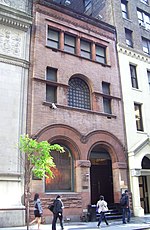Institute for State and Local Governance
The CUNY Institute for State and Local Governance (ISLG) is a research and policy organization based out of City University of New York. ISLG was founded in 2013 by Michael P. Jacobson, a former President of the Vera Institute of Justice and veteran government official under the Dinkins and Giuliani administrations in New York City.Marc Shaw, former First Deputy Mayor of Michael Bloomberg and Senior Advisor to CUNY's Chancellor for Fiscal Policy, serves as the Chair of the ISLG Advisory Board. Philanthropic partners of the Institute include The Rockefeller Foundation, the MacArthur Foundation, Open Society Foundations, and local and federal government agencies.
Excerpt from the Wikipedia article Institute for State and Local Governance (License: CC BY-SA 3.0, Authors).Institute for State and Local Governance
East 34th Street, New York Manhattan
Geographical coordinates (GPS) Address Nearby Places Show on map
Geographical coordinates (GPS)
| Latitude | Longitude |
|---|---|
| N 40.74791 ° | E -73.98396 ° |
Address
East 34th Street 10
10016 New York, Manhattan
New York, United States
Open on Google Maps






